|
|
|
brackish water and sunshine
Tuesday, October 4 2005
setting: Mitzpe Ramon, Southern Isræl
The road from Mitzpe Ramon towards the southeast dives immediately into "the crater" in a series of switchbacks. At the bottom, the crater is a rolling flatland with occasional belts of exposed volcanic rock in a golden desert sea of sandstone and limestone. As one continues southeastward, one rises ridges and then descends into lesser "craters," each a little more like a wadi and a little less like the result of a cosmic impact. As we drove, we played the perfect music for this landscape: pop-influenced Arab music. I've always loved Arab music, but (at least until the rise of broadband) it's been a hard thing to obtain in the West. Modern Arab pop actually draws from lots of influences, and in the past days I've heard songs with rap-style bridge and even country hoe-down intros. Ultimately, though, once the music kicks in, it's unmistakably Arab in character.
I've read that Islam makes sense in the desert in a way that people who don't frequent deserts cannot understand. I think the same is true of Arab music. I'm curious, too, about how this applies to Judaism. As presently practiced, extreme Jewish orthodoxy seems to be designed more for life in a dreary Eastern European shtetl than to the sundrenched sands that comprise a good half of the land of the modern Jewish state. I wonder how many generations of Isræli Hasids will sweat through their lives in long black coats, pressed white shirts, and tzitzis (that extra layer of cloth with the strands hanging out) before a little editing is done to their obdurate dress code. Chances are, though, there will always be some faction of Hasids in Isræl believing that they will be in violation of G-d's law unless they get up every morning and dress themselves like they're going to be spending the day selling knishes at an outdoor food stand in a Polish February.
Most Isrælis, though, seem to have adapted quickly to life in an arid Mediterannean climate.
In general, it can be said that the Jews are thriving in their ancient homeland. They're tanned and muscular, and many among the younger generations are rather tall. This shouldn't come as a surprise, given that so many of their genes evolved to cope in the land they now occupy. Add to this the smallness of the country, the hostility of its neighbors, and the consequent shortness of market routes, and you realize that Isrælis are eating the freshest, most macrobiotic food in the world. The result: Isræl's sabras are not the blanched pencil-necked nebbishes you may know from Jewish stereotypes.
A couple military checkpoints later, we were beside a mountaintop antenna nest looking out over the Arava Valley, the rift valley that is occupied further north by the Dead Sea and the Jordan Valley. Kibbutzim were rectangles of green, and one of those was our destination, the Kibbutz Lotan. There'd be a rendezvous with Gretchen's parents, who had also headed south after Dina's wedding but hadn't yet spent any time in Jerusalem.
A typical kibbutz in Isræl is industrious, communist, and avowedly secular, perhaps in appreciation of Karl Marx's metaphor likening religion to an opiate. The Kibbutz Lotan, however, is less secular than the average. Its communal kitchen is meticulously kosher, and religious holidays (such as Rosh Hashana, which lasts 49 hours) are celebrated with ritualized group services. Still, the attitude at these services is decidedly lefty, with the occasional hint of new age. When we arrived the Rosh Hashana pre-lunch service was concluding and a bunch of hippie teenagers from America were singing a Hebrew song about peace (shalom), though every other time they would go to say shalom they'd substitute in the Arabic word for peace (salam). Gosh, if Jews can do that, it's a wonder we can't all just take ecstasy and form a ginormous cuddle puddle! Cattiness aside, you have to give the youth some credit for their idealism, as handed down youth-counselor-to-youth year after postmodern year.
After lunch, we rode with Gretchen's parents in their rental car and Gretchen's father pointed out the various things they'd learned over the course of at least one additional day at the kibbutz. There was the ancient Roman road out in the desert that a recent flood had revealed. As we stood around looking at it, an Isræli army truck patrolling the Jordanian border (a couple hundred yards away) stopped and asked (in Hebrew) if we were okay. Strangers don't let strangers die in the desert.
Lying along an important Eurasian bird migration route, Kibbutz Lotan is trying to make a name for itself in the world of ecostourism. In the meantime, however, their cash cow continues to be primarily dates, followed by dairy products. Keep in mind that the whole of Kibbutz Lotan lies within the bleak Arava Desert. Any water that they use must be pumped out of the ground. And any food that their cows eat must be trucked in.
We walked around among the date palms, which were organized in two groves, each maybe ten acres in size. These had been the green rectangles we'd seen from the mountaintop to the west. The groves are smack dab in the middle of the desert, and to get the palms to grow, each gets its own personal irrigation hose. These hoses have perforations near where water is needed and the water drips out at a steady rate. Supposedly the Isrælis were the people who developed and perfected this irrigation technique. (If you ever hear anyone extolling the virtues of Isræl, inevitably you'll hear the term "invented drip irrigation" somewhere within the first hundred words.) The advantage of drip irrigation is obvious; water spends so little time in the atmosphere that little of it evaporates. The downside of drip irrigation is that it requires lots and lots of plastic hose. You see that hose everywhere in Isræl: coiled up on the back of trucks, in smushed fragments on the side of the road, or snaking abandoned through dead weeds in Mitzpe Ramon. Often it is brown in color so as to blend in better with the soil or perhaps to resemble copper. Here in the date groves of Kibbutz Lotan, the water is pre-mixed with fertilizer before reaching the palms. This accounted for the rich growth of algæ in the few puddles I saw at the base of the trees.
The water pumped from the subterranean aquifer is somewhat brackish and must be desalinized to make it potable for humans (people can drink it without dropping dead, but it's unpleasant). In the kibbutz, the desalinized water is only used for drinking. Everything else: dish washing, showering, flushing the toilet, and even irrigation, is done with brackish aquifer water. Not just any plant can tolerate such water, so the plants of Kibbutz Lotan had to be carefully selected (or else they would be selected naturally, if you know what I mean).
Date palms like brackish water just fine, but all this irrigation leaves me curious about the long term sustainability of this and other desert agricultural settlements throughout Isræl. Whenever you irrigate, you eventually concentrate salts in the topsoil, because the water contains trace amounts of salts and evaporates before it can rinse them (along with previously accumulated salts) away. The fact that Kibbutz Lotan is using water that is already brackish would seem to accelerate this process. Perhaps the solution to this problem is the sheer quantity of desert. Once the existing date groves are uselessly salinized, a new set of groves can be planted nearby.
Oddly, the residents at Kibbutz Lotan do very little of the actual work in the date groves. Instead, they host a bunch of guest workers from Indochina who are experienced in the ways of date harvesting. So then, with regard to the date operation: the water is pumped from deep beneath the ground, fertilizers are trucked in and added to the water, and people from thousands of miles away are brought in to harvest the dates when they mature. Why, exactly, is this being done in the Isræli desert? Is it just for the sunlight?
Much more dubious than the date plantation, however, is the Kibbutz Lotan dairy operation. Everything must be trucked in and out, particularly the enormous cubes of hay. And, unlike the date palms, cows require desalinized water to drink. For the cows, it's not an especially humane existence, since, living out their lives in a dense feeding lot, they're not exactly free range. Even the sun, so essential to the date palms, is more of a liability than an asset when it comes to domestic animals, since they require shade. The only possible reason I can imagine for raising cattle in a feedlot in the desert is the abundance of fresh air. If you didn't have to worry about issues of odor, the Kibbutz Lotan cattle operation could much more easily be conducted on a rooftop deck in Jerusalem, with the benefit of vastly-reduced transportation costs.
I grew up on a farm and my father was something of an expert in the field of thermodynamics, so I have an unusually comprehensive grounding in what is and what is not a feasible and/or sustainable farming operation. From what I saw at Kibbutz Lotan, I'm inclined to believe the whole thing is an elaborate front, probably heavily-subsidized by the government. The goal is obvious: to occupy the desert and show the Jordanians that Isrælis are really using that land, and perhaps rubbing the Jordanians' noses in the fact that they are not using their half of the Arava. In the end, though, I hope ecotourism works out for Kibbutz Lotan, because without it there's little rationale for its continued existence, particularly if the 11th plague (the one of peace) breaks out across the Holy Land.
We went down to a couple of bird watching blinds that the kibbutz had erected close along the Jordanian border to the south of the kibbutz proper. These blinds were made of adobe and hay and looked out over artificial wetlands funded by a project seeking to mitigate the replacing of wetlands with hotels down in the Isræli resort city of Eilat. Of course, artificial wetlands fed with aquifer water pumped up from the ground are rather different from, and of a completely different scale than, natural wetlands. Again, particularly after my crash course on impermanence in Jerusalem, I have my doubts about sustainability. While they exist, however, these wetlands may entice migrating birds to stop over and, incidentally, be observed by ecotourists. We didn't see anything too spectacular, but we were there at the worst possible time of day.
After an afternoon of kibbutz exploration and bird watching, we went off to take a swim in the kibbutz's enormous pool. It was an unexpected piece of luxury, completely out of proportion to the rest of the operation. Providing such luxury is the only way you can get people to sign onto the ascetic kibbutz way of life, or so Gretchen's father theorized.
In the evening, Gretchen and I walked around the residential part of the kibbutz looking at all the plants, art, and interesting construction. There's a creative energy pervading a kibbutz that has no analogue in American society. On a kibbutz, you have to make do with what you have, and trying to make big things happen within limits is the essence of creativity. At Kibbutz Lotan, one of the goals is to recycle absolutely everything, and lots of things which you might haul to the dump end up incorporated in sculpture (made by their artist-in-residence). The rest finds itself adding bulk to adobe walls, many of which we saw in various stages of construction.
After an evening Rosh Hashana service that gradually turned into an unexpectedly lavish dinner, there was a showing of the movie Yentl out on the lawn. I kid you not.

The desert on the road east of Mitzpe Ramon.

More of that desert.

The distant Arava viewed from highlands to the west. The date groves are green rectangles and the Jordanian border is just beyond them, running down the center of the valley.

Driving down towards the Arava.

Date grove at Kibbutz Lotan.

Gretchen greets one of the dogs associated with the Kibbutz Lotan dairy operation. There are still wolves living in this region, and dogs provide a useful warning function.

Gretchen grows impatient with her parents' constant bird watching.

Two dogs raising a fuss about a cat in a Kibbutz Lotan dumpster.
For linking purposes this article's URL is:
http://asecular.com/blog.php?051004 feedback
previous | next |







